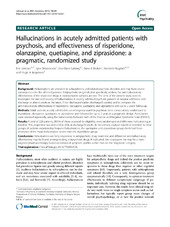| dc.contributor.author | Johnsen, Erik | en_US |
| dc.contributor.author | Sinkeviciute, Igne | en_US |
| dc.contributor.author | Løberg, Else-Marie | en_US |
| dc.contributor.author | Kroken, Rune A. | en_US |
| dc.contributor.author | Hugdahl, Kenneth | en_US |
| dc.contributor.author | Jørgensen, Hugo A. | en_US |
| dc.date.accessioned | 2013-11-12T14:00:07Z | |
| dc.date.available | 2013-11-12T14:00:07Z | |
| dc.date.issued | 2013-09-30 | eng |
| dc.Published | BMC Psychiatry 13(1):241 | eng |
| dc.identifier.issn | 1471-244X | |
| dc.identifier.uri | https://hdl.handle.net/1956/7523 | |
| dc.description.abstract | Background Hallucinations are prevalent in schizophrenia and related psychotic disorders and may have severe consequences for the affected patients. Antipsychotic drug trials that specifically address the anti-hallucinatory effectiveness of the respective drugs in representative samples are rare. The aims of the present study were to investigate the rate and severity of hallucinations in acutely admitted psychotic patients at hospital admission and discharge or after 6 weeks at the latest, if not discharged earlier (discharge/6 weeks); and to compare the anti-hallucinatory effectiveness of risperidone, olanzapine, quetiapine, and ziprasidone with up to 2 years’ follow-up. Methods Adult patients acutely admitted to an emergency ward for psychosis were consecutively randomized to risperidone, olanzapine, quetiapine, or ziprasidone and followed for up to 2 years in a pragmatic design. Participants were assessed repeatedly using the hallucinatory behavior item of the Positive and Negative Syndrome Scale (PANSS). Results A total of 226 patients, 30.5% of those assessed for eligibility, were randomized and 68% were hallucinating at baseline. This proportion was reduced to 33% at discharge/6 weeks. In the primary analyses based on intention to treat groups of patients experiencing frequent hallucinations, the quetiapine and ziprasidone groups both had faster decreases of the mean hallucination scores than the risperidone group. Conclusions Hallucinations are fairly responsive to antipsychotic drug treatment and differential anti-hallucinatory effectiveness may be found among existing antipsychotic drugs. If replicated, this could pave the way for a more targeted pharmacotherapy based on individual symptom profiles, rather than on the diagnostic category. | en_US |
| dc.language.iso | eng | eng |
| dc.publisher | BioMed Central Ltd. | eng |
| dc.rights | Attribution CC BY | eng |
| dc.rights.uri | http://creativecommons.org/licenses/by/2.0 | eng |
| dc.title | Hallucinations in acutely admitted patients with psychosis, and effectiveness of risperidone, olanzapine, quetiapine, and ziprasidone: a pragmatic, randomized study | en_US |
| dc.type | Peer reviewed | |
| dc.type | Journal article | |
| dc.date.updated | 2013-10-04T03:10:35Z | |
| dc.description.version | publishedVersion | en_US |
| dc.rights.holder | Erik Johnsen et al.; licensee BioMed Central Ltd. | |
| dc.rights.holder | Copyright 2013 Johnsen et al.; licensee BioMed Central Ltd. | |
| dc.identifier.doi | https://doi.org/10.1186/1471-244x-13-241 | |
| dc.identifier.cristin | 1055956 | |

